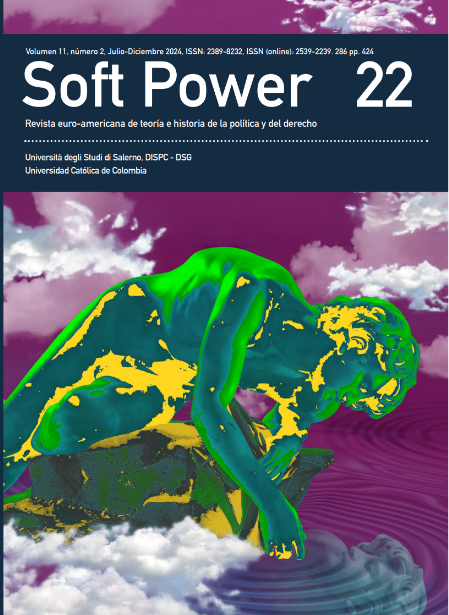
Esta obra está bajo una licencia internacional Creative Commons Atribución-NoComercial 4.0.
Al enviar los artículos para su evaluación, los autores aceptan que transfieren los derechos de publicación a Soft Power. Revista Soft Power para su publicación en cualquier medio. Con el fin de aumentar su visibilidad, los documentos se envían a bases de datos y sistemas de indización, así mismo pueden ser consultados en la página web de la Revista.Resumen
Si bien las tecnologías digitales han impregnado cada vez más todos los aspectos de nuestras vidas, la llegada de nuevas tecnologías, como la Realidad Virtual (RV), la IA generativa y las interfaces cerebro-ordenador, extiende la influencia de las tecnologías a una profundidad sin precedentes, dando paso a la generación de experiencia, conocimiento (o una pretensión del mismo) y expresiones comunicativas, así como a la eliminación de la propia separación entre lo biológico y lo digital/mecánico. En tales circunstancias, la idea de un yo independiente (si es que alguna vez existió) se hace estructuralmente imposible. En su lugar, el yo se entrelaza con las tecnologías digitales hasta el punto de la co-constitución. En este caso, el yo es susceptible de ser pirateado de dos formas importantes. Una es a través de las actividades cibercriminales más tradicionales. En particular, los ataques con joysticks humanos relacionados con entornos de RV y, potencialmente, con interfaces cerebro-ordenador. Sin embargo, podría sostenerse en un nivel más fundamental que es posible lograr los mismos resultados sin piratear. De hecho, esta es exactamente la forma en que ya tiene lugar la gobernanza algorítmica corporativa del yo digitalmente enredado. En concreto, esto implica la
estructuración de espacios digitales y, de cara al futuro, el control corporativo de interfaces cerebro-ordenador, así como la formación y propiedad de modelos de IA, todo lo cual ayuda a estructurar el yo individual teniendo en cuenta los intereses corporativos, más que los personales. En combinación, estos dos modos de determinación se consideran formas alternativas, pero estructuralmente similares de piratear el yo y, de hecho, convertir a los individuos en joysticks humanos controlados por una mano intangible, pero no por ello menos potente.

Citas
Ajrawi, S., Rao, R., & Sarkar, M. (2021). Cybersecurity in Brain-Computer Interfaces: RFID-Based Design-Theoretical Framework. Informatics in Medicine, 22, 1-9. https://doi.org/10.1016/j.imu.2020.100489
Anany, M. (2024). Making Generative Artificial Intelligence a Public Problem: Seeing Publics and Sociotechnical Problem-Making in Three Scenes of AI Failure. Javnost – The Public, 31(1), 89-105. https://doi.org/10.1080/13183222.2024.2319000
Arguedas, A. R. & Simon, F. M. (2024). Automating Democracy: Generative AI, Journalism, and the Future of Democracy. Oxford Internet Institute, https://www. oii.ox.ac.uk/news-events/reports/automating-democracy-generative-ai-journalism- and-the-future-of-democracy/.
Bailenson, J. (2018). Experience on Demand: What Virtual Reality Is, How It Works, and What It Can Do. W. W. Norton and Company.
Balakrishnan, J. and Dwivedi, Y. K. (2024). Conversational Commerce: Entering the Next Stage of AI‑Powered Digital Assistants. Annals of Operations Research, 333,653–687. https://doi.org/10.1007/s10479-021-04049-5
Bannerman, S. (2024). Platform Imperialism, Communications Law and Relational Sovereignty. New Media & Society, 26(4), 1816-1823. https://doi.org/10.1177/14614448221077284
Bay, M. (2023). Arendt in the Metaverse: Four Properties of eXtended Reality that Imperil Factual Truth and Democracy. Convergence: The International Journal of Research into New Media Technologies, 29(6), 1698-1712. https://doi. org/10.1177/13548565231199957
Beckett, C. (2019). New Powers, New Responsibilities: A Global Survey of Journalism and Artificial Intelligence. LSE Polis, https://blogs.lse.ac.uk/polis/2019/11/18/ new-powers-new-responsibilities/.
Beckett, C. & Yaseen, M. (2023). Generating Change: A Global Survey of What News Organisations Are Doing With AI. LSE Polis, https://www.journalismai.info/s/Generating- Change-_-The-Journalism-AI-report-_-English.pdf.
Boden, M. A. (2016). AI: Its Nature and Future. Oxford University Press. Branca, G., Resciniti, R., & Loureiro, S. M. C. (2023). Virtual Is so Real! Consumers’ Evaluation of Product Packaging in Virtual Reality. Psychology & Marketing, 40(3), 596–609. https://doi.org/10.1002/mar.21743
Brandtzaeg, P. B., Skjuve, M., & Følstad, A. (2022). My AI Friend: How Users of a Social
Chatbot Understand Their Human-AI Friendship. Human Communication Research, 48(3), 404–429. https://doi.org/10.1093/hcr/hqac008
Brocal, F. (2023). Brain-Computer Interfaces in Safety and Security Fields: Risks and Applications. Safety Science, 160, 1-16. https://doi.org/10.1016/j.ssci.2022.106051
Canavilhas, J. (2022). Artificial Intelligence and Journalism: Current Situation and Expectationsin the Portuguese Sports Media. Journalism and Media, 3(3), 510–520.https://doi.org/10.3390/journalmedia3030035
Cayir, D. et al. (2024). Augmenting Security and Privacy in the Virtual Realm: An Analysis of Extended Reality Devices. IEEE Security & Privacy Magazine. https://doi. org/10.1109/MSEC.2023.3332004
Chalmers, D. J. (2022). Reality +: Virtual Worlds and the Problems of Philosophy. W. W. Norton & Company.
Chan, J. (2024). Online Astroturfing: A Problem Beyond Disinformation. Philosophy and Social Criticism, 50(3), 507-528. https://doi.org/10.1177/01914537221108467
Chow, Y.-W. et al. (2023). Visualization and Cybersecurity in the Metaverse: A Survey. Journal of Imaging, 9(1), 1-15. https://doi.org/10.3390/jimaging9010011
Coeckelbergh, M. (2023). Democracy, Epistemic Agency, and AI: Political Epistemology in Times of Artifcial Intelligence. AI and Ethics, 3, 1341–1350. https://doi.org/10.1007/s43681-022-00239-4
Edwards, L. et al. (2024). Private Ordering and Generative AI: What Can We Learn from Model Terms and Conditions? CREATe Working Paper 2024/5. https://doi. org/10.2139/ssrn.5026677
Eg, R., Tønnesen, Ö. D., Tennfjord, M. K. (2023). A Scoping Review of Personalized User Experiences on Social Media: The Interplay Between Algorithms and Human Factors. Computers in Human Behavior Reports, 9, 1-17. https://doi.org/10.1016/j.
chbr.2022.100253
Ferrara, E. (2024). GenAI against Humanity: Nefarious Applications of Generative Artificial Intelligence and Large Language Models. Journal of Computational Social Science, 7, 549–569. https://doi.org/10.1007/s42001-024-00250-1
Flavián, C., Ibáñez-Sánchez, S., & Orús, C. (2019). The Impact of Virtual, Augmented and Mixed Reality Technologies on the Customer Experience. Journal of Business Research, 100, 547-560. https://doi.org/10.1016/j.jbusres.2018.10.050
Greenbaum, D. (2021). Cyberbiosecurity: An Emerging Field that has Ethical Implications for Clinical Neuroscience. Cambridge Quarterly of Healthcare Ethics, 30(4), 662–668. https://doi.org/10.1017/S096318012100013X
Guerreiro, J. & Loureiro, S. M. C. (2023). I Am Attracted to My Cool Smart Assistant! Analyzing Attachment-Aversion in AI-Human Relationships. Journal of Business Research, 161, 1-13. https://doi.org/10.1016/j.jbusres.2023.113863
Hagar, N. & Diakopoulos, N. (2023). Algorithmic Indifference: The Dearth of News Recommendations of TikTok. New Media & Society. https://doi.org/10.1177/14614448231192964
Hall, A.-N., Chadwick, A., & Vaccari, C. (2024). Online Misinformation and Everyday Ontological Narratives of Social Distinction. Media, Culture & Society, 46(3), 572- 590. https://doi.org/10.1177/01634437231211678
Han, D.-I. D., Bergs, Y., & Moorhouse, N. (2022). Virtual Reality Consumer Experience Escapes: Preparing for the Metaverse. Virtual Reality, 26, 1443–1458. https://doi.org/10.1007/s10055-022-00641-7
Hepp, A. & Couldry, N. (2023). Necessary Entanglements: Reflections on the Role of a ‘Materialist Phenomenology’ in Researching Deep Mediatization and Datafication. Sociologica, 17(1), 137-153.
Hepp, A. et al. (2023). ChatGPT, LaMDA, and the Hype Around Communicative AI: The Automation of Communication as a Field of Research in Media and Communication Studies. Human-Machine Communication, 6, 41-62. https://doi.org/10.30658/hmc.6.4
Huang, Y.C., Li, L.N., Lee, H.Y., Browning, M.H. and Yu, C.P. (2023), Surfing in virtual reality: an application of extended technology acceptance model with flow theory. Computers in Human Behavior Reports, 9, 100252. https://doi.org/10.1016/j.chbr.2022.100252
Jayawardena, N. S., Thaichon, P., Quach, S., Razzaq, A., & Behl, A. (2023). The Persuasion Effects of Virtual Reality (VR) and Augmented Reality (AR) Video Advertisements: A Conceptual Review. Journal of Business Research, 160, 1-17. https://doi.org/10.1016/j.jbusres.2023.113739
Jiang, C. (2022). The Making of Popstar Fembots: Participation, Co-Creation, or online Cultural Exploitation? Hybrid: Journal of Arts and Human Mediations, 8, 1-12. https://doi.org/10.4000/hybrid.2254 Judson, E., Fisher, S. A., Howard, J. W., Kira, B., Basavaraj, K. A., & Perry, H. (2024). Synthetic Politics” Preparing Politics: Preparing Democracy for Generative AI. Demos.
Jungherr, A. (2023). Artificial Intelligence and Democracy: A Conceptual Framework. Social Media + Society, 9(3). https://doi.org/10.1177/20563051231186353
Jungherr, A. & Schroeder, R. (2023). Artificial Intelligence and the Public Arena. Communication Theory, 33(2-3), 164-173. https://doi.org/10.1093/ct/qtad006
Kalpokas, I. (2024a) Technological Governance and Escapism in Times of Accelerated Change. Palgrave Macmillan. https://doi.org/10.1007/978-3-031-60890-2
Kalpokas, I. (2024b). Post-Truth and Information Warfare in their Technological Context. Applied Cybersecurity and Internet Governance, 3(2), 99-121. https://doi.org/10.60097/ACIG/190407
King, B. J., Read, G, J. M., & Salmon, P. M. (2024) The Risks Associated with the Use of Brain-Computer Interfaces: A Systematic Review. International Journal of Human- Computer Interaction, 40(2), 131-148. https://doi.org/10.1080/10447318.2022.2111041
Knight, W. (2023, October 12). The Chatbots Are Now Talking to Each Other. Wired. https://www.wired.com/story/fast-forward-the-chatbots-are-now-talking-to-eachother/
Kukkakorpi, M. & Pantti, M. (2021). A Sense of Place: VR Journalism and Emotional Engagement. Journalism Practice, 15(6), 785-802. https://doi.org/10.1080/17512786.2020.1799237
Lemley, M. A. & Volokh, E. (2018). Virtual Reality and Augmented Reality. University of Pennsylvania Law Review, 66(5), 1051-1138. https://doi.org/10.2139/ssrn.2933867
Lin, C. C. & Hsu, Y. C. (2023). The New Ethical Thinking in CGI Immersive Journalism. Convergence: The International Journal of Research into New Media Technology, 29(4), 1033-1053. https://doi.org/10.1177/13548565231176177
Liv, N. (2021). Neurolaw: Brain-Computer Interfaces. University of St. Thomas Journal of Law and Public Policy, 15(1), 328-355.
López Bernal, S., Huertas Celdrán, A., Fernández Maimó, L., Barros, M. T., Balasubramaniam, S., & Martínez Pérez, G. (2020). Cyberattacks on Miniature Brain Implants to Disrupt Spontaneous Neural Signalling. IEEE Access, 8, 1-19. https://doi. org/10.1109/ACCESS.2020.3017394
Mabrook, R. (2021). Between Journalist Authorship and User Agency: Exploring the Concept of Objectivity in VR Journalism. Journalism Studies, 22(2), 209-224. https:// doi.org/10.1080/1461670X.2020.1813619 Maiseli, B., Abdalla, A. T., Massawe, L. V., Mbise, M., Mkocha, K., Nassor, N. A., Ismail,
M., Michael, J., & Kimambo, S. (2023). Brain-Computer Interface: Trend, Challenges, and Threats. Brain Informatics, 10, 1-16. https://doi.org/10.1186/s40708-023-00199-3
Mazarr, M. J., Bauer, R., Casey, A., Heintz, S., & Matthews, L. J. (2019). The Emerging Risk of Virtual Societal Warfare: Social Manipulation in a Changing Information Environment.
The RAND Corporation. https://doi.org/10.7249/RR2714
McLay, R. (2018). Managing the rise of Artificial Intelligence. Australian Human Rights Commission. https://tech.humanrights.gov.au/sites/default/files/inline-files/100%20-%20Ron%20%20McLay.pdf%20
Newman, N. (2023). Journalism, Media, and Technology Trends and Predictions 2023. Reuters Institute for the Study of Journalism. https://reutersinstitute.politics.ox.ac.uk/sites/default/files/2023-01/Journalism_media_and_technology_trends_and_predictions_2023.pdf
Odeleye, B., Loukas, G., Heartfield, R., Sakellari, G. Panaousis, E., & Spyridonis, F.(2023). Virtually Secure: A Taxonomic Assessment of Cybersecurity Challenges in Virtual Reality Environments. Computers & Security, 124, 1-17. https://doi. org/10.1016/j.cose.2022.102951
Offenhuber, D. (2024). Shapes and Frictions of Synthetic Data. Big Data & Society, 11(2). https://doi.org/10.1177/20539517241249390
Palmieri, E. (2024). Online Bubbles and Echo Chambers as Social Systems. Kybernetes, 54(4), 2457-2468. https://doi.org/10.1108/K-09-20231742
Pavlik, J. V. (2023). Collaborating With ChatGPT: Considering the Implications of Generative Artificial Intelligence for Journalism and Media Education. Journalism & Mass Communication Educator, 78(1), 84–93. https://doi.org/10.1177/10776958221149577
Peña-Fernández, S., Meso-Ayerdi, K., Larrondo-Ureta, A., & Díaz-Noci, J. (2023).Without Journalists, There Is no Journalism: The Social Dimension of Generative Artificial Intelligence in the Media. El Profesional de La Información, 23(2), 1-15. https://doi.org/10.3145/epi.2023.mar.27
Porlezza, C. (2024). The Datafication of Digital Journalism: A History of Everlasting Challenges Between Ethical Issues and Regulation. Journalism, 25(5), 1167-1185. https://doi.org/10.1177/14648849231190232
Rinehart, A. & Kung, E. (2022). Artificial Intelligence in Local News: A Survey of US Newsrooms’ AI Readiness. The Associated Press Technical Report, https://www.researchgate. net/publication/363475725_Artificial_Intelligence_in_Local_News_A_
survey_of_US_newsrooms’_AI_readiness.
Rubin, P. (2020). Future Presence: How Virtual Reality is Changing Human Connection,MIntimacy, and the Limits of Ordinary Life. Harper One.
Schaetz, N., Gagrčin, E., Toth, R., & Emmer, M. (2023). Algorithm Dependency and Platformized News Use. New Media & Society, 27(3), 1360-1377. https://doi.org/10.1177/14614448231193093
Scholz, J. & Duffy, K. (2018). We ARe at Home: How Augmented Reality Reshapes Mobile Marketing and Consumer-Brand Relationships. Journal of Retailing and Consumer Services, 44, 11-23. https://doi.org/10.1016/j.jretconser.2018.05.004
Schöne, B., Kisker, J., Lange, L., Gruber, T., Sylvester, S., & Osinsky, R. (2023). The reality of Virtual Reality. Frontiers in Psychology, 14, 1-17. https://doi.org/10.3389/fpsyg.2023.1093014
Shin, D., Koerber, A., & Lim, J. S. (2024). Impact of Misinformation from GenerativeAI in User Information Processing: How People Understand Misinformation fromGenerative AI. New Media & Society. https://doi.org/10.1177/14614448241234040
Tomlinson, B., Patterson, D. J., & Torrance, A. W. (2023). Turning Fake Data into FakeNews: The AI Training Set as a Trojan Horse for Misinformation. San Diego Law Review, 60, 641-670.
van Dalen, A. (2023). Algorithmic Gatekeeping for Professional Communicators: Power,Trust, and Legitimacy. Routledge. https://doi.org/10.4324/9781003375258
van Dijck, J. (2024). Governing Platforms and Societies. Platforms & Society, 1, 1-2.https://doi.org/10.1177/29768624241255922
Vondráček, M., Baggili, I., Casey, P., & Mekni, M. (2023). Rise of the Metaverse’s Immersive
Virtual Reality Malware and the Man-in-the-Room Attack & Defenses. Computers & Security, 127, 1-19. https://doi.org/10.1016/j.cose.2022.102923
Weikmann, T. & Lecherer, S. (2023). Visual Disinformation in a Digital Age: A Literature Synthesis and Research Agenda. New Media & Society, 25(12), 3696-3713. https://doi.org/10.1177/14614448221141648
Williams, R. (2024, May 31). Why Google’s AI Overviews Gets Things Wrong? MIT Technology Review, https://www.technologyreview.com/2024/05/31/1093019/whyare- googles-ai-overviews-results-so-bad/.
Zhang, G. et al. (2022). Popularity of the Metaverse: Embodied Social Presence Theory Perspective. Frontiers in Psychology, 13, 1-13. https://doi.org/10.3389/ fpsyg.2022.997751









